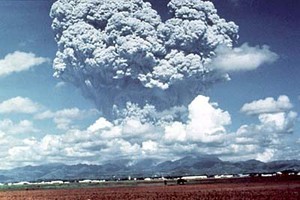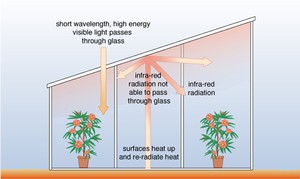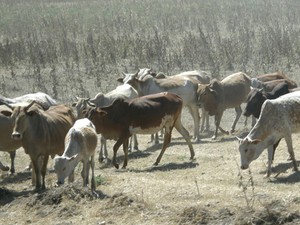What are the causes of climate change?
We mentioned earlier that cyclical variations in the global climate have been occurring for millions of years because of shifts in natural environmental factors. We briefly describe two of the main natural causes of climate change before turning to those that can be attributed to human activity.
Natural causes of climate change
The amount of energy reaching the Earthas heat from the sun has varied over millennia due to changes in the intensity of activity in the sun’s magnetic core. The average temperature of the Earth’s surface increases when solar activity is high and decreases when solar activity is reduced. These changes in the intensity of solar activity take place in cycles lasting hundreds of years, with profound effects on the Earth’s climate. For example, between the 17th and 19th centuries, winters in the northern hemisphere were unusually long and cold, leading to reduced growing seasons, widespread crop failure and famine. This period has become known as the ‘Little Ice Age’ and is thought to have been caused partly by low solar activity.
The global climate can also be influenced by volcanic eruptions. The explosion of dust particles, ash, water vapour and gases such as sulphur dioxide into the atmosphere is dispersed around the globe and reflects sunlight back into space.
What effect do you think volcanic eruptions could have on the Earth’s surface temperature?
If some of the energy from sunlight is reflected back into space by the dust in the atmosphere, the average surface temperature of the Earth is likely to be reduced.
Even though the volcanic eruption may last only a few days, the effect on the global climate may last for several years. For example, the average surface temperature in the northern hemispherewas reduced by about 0.5 °C for a few years after the eruption of Mount Pinatubo in the Philippines in June 1991 (Figure 9.4).

Figure 9.4 The eruption of Mount Pinatubo, Philippines, released huge amounts of dust particles and gas into the atmosphere.
Solar activity and volcanic eruptions cannot be modified by human interventions. However, human activity is increasingly seen as a direct cause of climate change from the 20th century onwards.
How do greenhouse gases contribute to climate change?
Climate change has been accelerating in recent decades in part due to increasing emissions into the atmosphere of so-called greenhouse gases generated by a range of human activities. We will explain why they have been given this name in a moment, but first note from Figure 9.5 how the atmospheric concentration of the major greenhouse gases – carbon dioxide, methane and nitrous oxide – has changed over the past 2000 years. It remained constant until about 1750, but then began rising, with dramatic increases since about 1900. These recent increases are attributed to human industrial and domestic activity.

Figure 9.5 Changes in the atmospheric concentration of carbon dioxide, methane and nitrous oxide over the last 2000 years, measured in parts per million (ppm) or parts per billion (ppb). (IPCC, 2007a)
These gases have been called ‘greenhouse’ gases because they act like the glass or plastic sheeting in a greenhouse (see Figure 9.6). Sunlight has a short wavelength and high energy, which enables it to pass through the glass into the greenhouse. Sunlight energy heats the air, plants, soil and structures in the greenhouse, and some of this heat energy is radiated back towards the glass in the form of infra-red radiation. However, infra-red radiation has a long wavelength and low energy, which means it is not able to pass back out through the glass, so the radiated heat remains in the greenhouse causing it to heat up very quickly. This phenomenon increases the productivity of greenhouse crops because plants grow faster in the higher temperature.


Figure 9.6 (a) Plastic greenhouses used for flower growing in Ethiopia and (b) the greenhouse effect.
A similar process happens at a global scale. Global warming is partly due to the effect of greenhouse gases in the atmosphere. Sunlight has enough energy to pass through these gases in the Earth’s atmosphere, so it reaches the Earth’s surface and transmits heat energy. Some of this heat energy is radiated back from the Earth’s surface into the atmosphere as lower-energy infra-red radiation. The greenhouse gases in the atmosphere absorb some of this infra-red radiation and reflect it back towards the Earth, causing the Earth’s temperature to heat up a bit more (Cunningham and Cunningham, 2006).
This greenhouse effect is a natural phenomenon. It is crucial for the survival of life on Earth because it maintains a global average temperature of about 15 °C. Without the greenhouse effect our global average temperature would be much colder: about –18 °C. However, human industrial and domestic activity since the start of the 20th century has released rapidly increasing amounts of greenhouse gases into the atmosphere. As a consequence, more sunlight energy is trapped close to the Earth because even less of the radiated heat can escape through the thicker shield of greenhouse gases surrounding the Earth.
How are greenhouse gases generated?
Human civilisation is highly dependent for its sources of energy on burning fossil fuels such as coal, oil and natural gas. Fossil fuels are formed over millions of years from the decayed remains of living organisms buried underground. The burning of fossil fuels, wood and compressed animal dung generates large amounts of carbon dioxide (CO2), one of the major greenhouse gases. Carbon dioxide remains in the atmosphere for many years and causes the Earth’s surface temperature to rise as a result of the greenhouse effect. Figure 9.7 shows that the concentration of atmospheric CO2 increased from 280 ppm in 1958, to more than 380 ppm in 2010 (IPCC, 2013).

Figure 9.7 The concentration of carbon dioxide in the atmosphere from 1958 to 2010 measured in ppm at Mauna Loa, Hawaii. (Scripps, 2007)
There are natural processes on Earth that, to some extent, balance the generation of carbon dioxide. For example, all green plants remove CO2 from the atmosphere in the process of photosynthesis. Plants, especially forests, oceans and wetlands are all important carbon sinks. Carbon sink is the term used to describe natural systems that absorb and store carbon dioxide from the atmosphere. However, as Figure 9.7 shows these balancing processes are not able to keep up with the rate of CO2 generation.
Another important greenhouse gas is methane (CH4), which is increasing in the atmosphere as a result of two main aspects of human activity: the decomposition of organic solid waste, and livestock farming. The digestive processes of ruminant animals such as cows (Figure 9.8), sheep and goats produce and release large amounts of methane gas (USEPA, n.d.; NASA, n.d.).

Figure 9.8 Cattle produce methane gas when they digest plant material.
Nitrous oxide (N2O) is another major greenhouse gas. It is generated from human activities such as burning organic materials, vehicle exhaust emissions and the production and use of organic fertilisers (USEPA, n.d.; NASA, n.d.). The concentration of N2O in the atmosphere has increased from the pre-industrial level of 270 parts per billion (ppb) to about 324 ppb in 2011 (IPCC, 2013).
Now that you know about the pattern of climate change at a global level and how it is affected by human activities, we can turn our attention to the effects in Ethiopia in the final section of this study session.